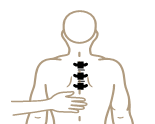We think our arms hang from our shoulders but in fact, we have reflexes in our arms that support the body. When we interfere with the supporting reflexes in the arms, the arms do not support themselves easily and feel as though they hang heavily from the shoulders. Our arms support us not only when we are on all fours but also when our hands are not in contact with the ground. As discussed in my previous blog ‘A Look At Gravity’, the skeleton conducts support to parts of the body that are not in contact with the ground. Conscious awareness of this possibility activates the supporting reflexes. The supporting reflexes are then available for use and our hands have the potential to support our arms.
The brain and the nervous system are vital factors of all movement. The brain executes a command for movement; the nerves send the command to the muscles. The collective action of muscle and nerve maintains a muscular tone. When this is consciously realized and the reflexes of support are dynamically organized, we can allow our shoulders to float. When our shoulders float, it takes the drag of our arms, scapulae, and clavicle off the ribs and ultimately of the spine. In this way, our reflexes of support indicate a four-legged structure that comes from vertical climbing. When the reflexes are active, our hands and our arms have the capacity to support our shoulders. Not only do our feet and legs support the spine but our hands and arms also support the spine.
In 1932 F. M. Alexander (The Use of the Self, Gollancz,1990, p.21) discusses the problems of conscious awareness and the separation of the mental and physical:
“I must admit that when I began my investigation, I, in common with most people, conceived of ‘body’ and ‘mind’ as separate parts of the same organism, and consequently believed that human ills, difficulties and shortcomings could be classified as either ‘mental’ or ‘physical’ and dealt with on specifically ‘mental’ or specifically ‘physical’ lines. My practical experiences, however, led me to abandon this point of view and readers of my books will be aware that the technique described in them is based on the opposite conception, namely, that it is impossible to separate ‘mental’ and ‘physical’ processes in any form of human activity.”
He goes on to say (p.22):
“…it is possible during a course of lessons to demonstrate to the pupil how the mental and physical work together in the use of the self in all activity.”
He adds as a footnote (p.22):
“I wish to make it clear that when I employ the word ‘use’, it is not in that limited sense of the use of any specific part, as, for instance, when we speak of the use of an arm or the use of a leg, but in a much wider and more comprehensive sense applying to the working of the organism in general. For I recognize that the use of any specific part such as the arm or leg involves of necessity bringing into action the different psycho-physical mechanisms of the organism, this concerted activity bringing about the use of the specific part.”
He asks the question (p.35):
“This led me to a long consideration of the whole question of the direction of the use of myself. ‘What is this direction,’ I asked myself, ‘upon which I have been depending?”
Concluding with the footnote (p.35):
“When I employ the words ‘direction’ and ‘directed’ with ‘use’ in such phrases as ‘direction of my use’ and ‘I directed the use’, etc. I wish to indicate the process involved in projecting messages from the brain to the mechanisms and in conducting the energy necessary to the use of these mechanisms.”
Therefore, we can say that when we allow the feet to be in a fully supporting reaction with the floor, the head, neck, and back can be in an appropriate dynamic relationship, everything else works in a more coordinated, efficient way. The neck is be allowed to be free so that the head can be supported in a balance forward and upward in such a way that allows the spine to lengthen and the torso is able to release and widen.
